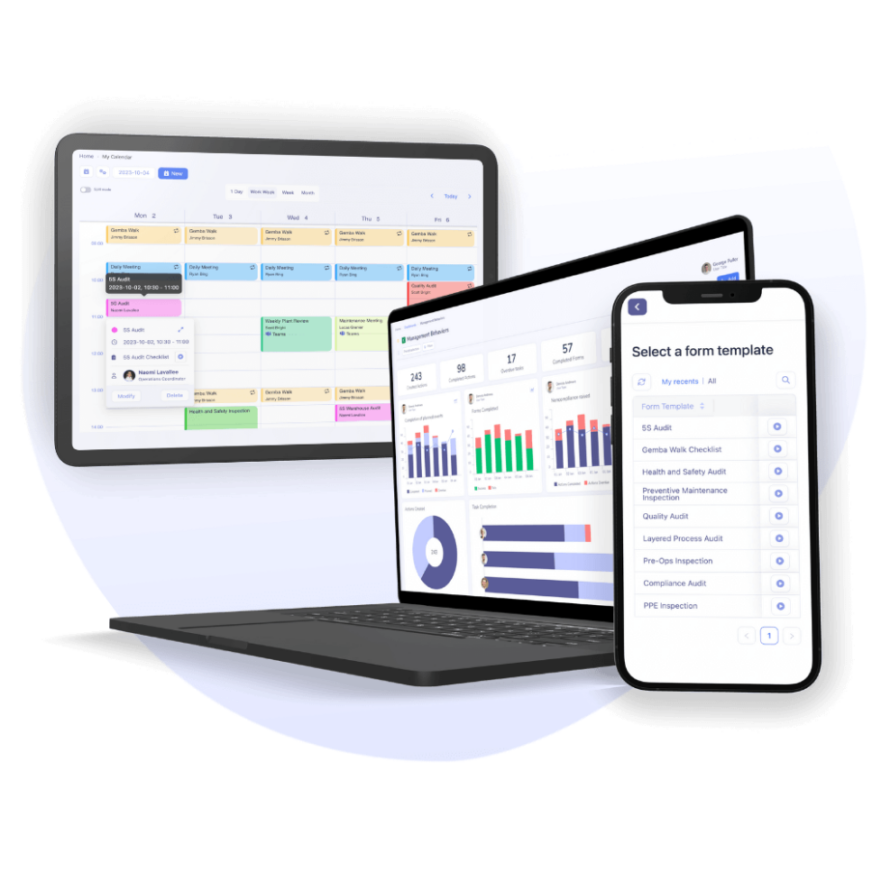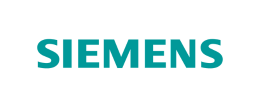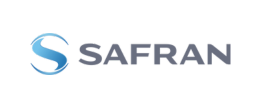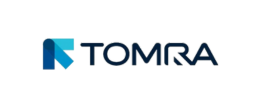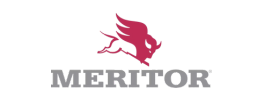5S Audit: Sample Questions for Checklists

| Audience: | Manufacturing Managers, Healthcare Administrators, Operational Excellence and Lean Management Practitioners, HR Coordinators, Organizational Leaders |
| Last updated: | July 30, 2025 |
| Read time: | 5 min |
- Conduct audits regularly: Schedule audits when setting up a new 5S area, after significant changes, and before formal inspections.
- Use checklists: Create checklists to guide your audits and ensure that all aspects of the 5S methodology are covered.
- Consider a digital tool: A tool like Tervene can streamline your audits, save time, and provide valuable insights into your workspace’s performance.
Five steps, one system: 5S is a must for any worksite to organize and optimize its operations. It reduces daily inefficiencies, improves workplace safety, and minimizes time, movement, and resource waste. Over time, though, a 5S audit must come into play to prevent standards from going wayward.
The question then is, how can one conduct these audits effectively? Here, a digital tool like Tervene becomes invaluable to offer a streamlined, tech-driven approach and conduct thorough audits.
What is a 5S checklist?
A 5S audit is a simple way to check if your workplace is clean, organized, and running smoothly. It helps you spot problems early and keep everything in good shape.
The “5S” stands for five steps:
- Sort → keep only what you need for your efficient workspace.
- Set in order → arrange items so they’re easy to find.
- Shine → clean the work area.
- Standardize → make these steps part of your daily routine.
- Sustain → keep it going over time.
When you do a 5S program, you’re reviewing how well your team is following these steps. It’s about finding ways to improve.
You’ll typically use a checklist during the audit. This helps you stay focused and makes sure you don’t miss anything. You might check things like:
- Are tools stored in the right place?
- Are walkways clear?
- Is equipment clean and ready to use?
5S audits are quick and easy. Many teams do them weekly or monthly. The goal is to build good habits and create an efficient workplace where everyone can do their best work.
Why conduct a 5S audit in a warehouse or manufacturing setting?
The idea is to consistently review processes to ensure the 5S method is followed correctly. This way, we keep our work environment up to par and fully benefit from the 5S approach.
When Setting up Your 5S Workstation
An initial audit is vital once you’ve got your 5S area up and running. This preliminary step helps you see how well everyone’s sticking to the plan.
After the 5S Area Is in Action
It’s wise to schedule regular audits, like weekly or monthly, to ensure our teams keep up with the established 5S standards.
When Significant Changes Happen
As a rule of thumb, run an audit if there are significant shifts in the workplace, like new processes, equipment, or workstations. This update checks how well these recent changes fit the 5S principles.
Before Formal Inspections or Quality Control
5S audits are ideal prep steps for standard inspections or quality reviews. They help make sure everything’s up to the mark.
When it comes to 5S audits, checklists are fundamental. They guide you through the process to ensure that every little detail is covered for optimal workspace organizations. It’s a practical approach to keep everything running smoothly and significantly supports your team’s well-being. It’s all about staying organized and efficient – a simple yet effective strategy.
5S audit checklists assess the implementation and conformity of the overarching methodology: Sort, Set in Order, Shine, Standardize, and Sustain.
Here are some sample questions for your 5S checklists:
1. Sort (Seiri)
The first pillar of the 5S project involves identifying excessive elements and creating an ergonomic work environment. Among the questions that may arise, here are a few:
- Have unnecessary items in your workspace been removed?
- Do drawers and storage areas contain only essential items?
- Are all documents stored in the workspace necessary?
- Has excess stock in storage areas been reduced?
- Is the floor clear of unwanted accessories or equipment that might cause accidents?
- Are items in the workspace well-organized and clearly labeled?
- Is there a routine in place for identifying and removing items that are no longer needed?
2. Set in Order (Seiton)
This second step aims to intuitively organize the workspace to minimize movements and quickly provide access to the most frequently used objects and machines.
Several questions are, therefore, relevant in the context of a 5S audit:
- Are tools, materials, and equipment arranged for an efficient workflow?
- Are there clearly defined locations for all items?
- Are labels and signage used to indicate storage locations?
- Have clear procedures for storage been established, including documentation on specific locations for each item?
- Has a visual system (such as labels, symbols, and drawings) been implemented to facilitate the storage of tools and equipment?
- Does each tool have a dedicated place, and are frequently used items easily accessible?
- Does the storage of tools follow a logical order based on their use in processes?
- Are there occurrences of time loss during the search for materials or documents?
3. Shine (Seiso)
Once you complete the storage analysis, you need to inspect cleanliness. If you have implemented the 5S methodology well, all these questions should receive affirmative answers.
- Is the workspace clean, including the floor, work surface, and shelves?
- Is maintenance of machines and equipment carried out up-to-date by the planned schedule?
- Are wastes managed appropriately, either by disposal or recycling?
- Are tools and equipment properly maintained and cleaned?
4. Standardize (Seiketsu)
The 5S audit also allows for verifying that the standardization is not failing. It is possible to ask:
- Are regular 5S audits conducted at each workstation to ensure compliance with standards?
- Have employees received adequate training on 5S standards?
- Are standard operating procedures (SOPs) in place and readily accessible?
- Are there visual standards for organization and cleanliness?
5. Sustain (Shitsuke)
Follow-up is crucial to ensure that the 5S processes are respected. Several questions have their place in an audit to carry out this analysis effectively:
- Are all employees consistently following the established rules of the 5S program?
- Have measurable improvements in workplace performance been observed since the implementation of the 5S methodology?
- Are new team members receiving comprehensive training on the principles of 5S to integrate them effectively into the system?
- Are regular meetings organized to discuss and analyze the results and benefits of applying the 5S practices?
- Are designated teams responsible for maintaining and enforcing the 5S standards in different areas or departments?
- Is a program or system in place to acknowledge and reward employees who actively contribute to the 5S process?
- Are before-and-after pictures or other visual tools used to illustrate the tangible successes and improvements achieved through 5S?
- Is there an ongoing process for the periodic review and reinforcement of 5S principles to keep them at the forefront of operational practices?
Indeed, one can customize the set of questions for 5S audits to align with each factory’s specific processes and needs.
Tervene offers comprehensive solutions for 5S audits.

Industry leaders leverage Tervene to perform their audits & inspections

How can you customize and implement your 5S template?
No two workplaces are exactly the same. That’s why it’s smart to customize your 5S audit checklist. You want it to fit your space, your team, and the way you work.
Start by thinking about your work area. What tools do you use? What problems tend to pop up? What do you want to keep an eye on in your efficient workspace? Your answers will help shape the checklist.
Here are a few ways you can make your checklist your own:
- Match it to your space → a checklist for an office will look very different from one for a machine shop.
- Use simple language → write questions your team will understand at a glance.
- Focus on your priorities → if safety is a big concern, add more questions about hazards and walkways.
- Keep it short → the best checklists are quick to use. Aim for just the essentials.
- Ask your team → they know the space best. Get their input on what to include.
Once you’ve built your checklist, test it out. See if it helps catch issues and improve the space. Tweak it as you go.
And remember: A good checklist grows with your team. It should always help you work smarter, not harder.
Discover Tervene’s audits & inspections tools
How often should you update your 5S audit template?
Your efficient workplace isn’t frozen in time – things change. And when they do, your 5S audit checklist should change too.
You don’t need to rewrite it every week. But you do want to review it regularly to keep it useful.
Here’s a simple way to think about it:
| Situation | Action |
| Every 3-6 months | Routine review and small updates |
| After new equipment is added | Update checklist to reflect changes |
| After process or layout changes | Review and adjust checklist |
| If audits feel repetitive or stale | Refresh questions and format |
| After team feedback | Tweak checklist based on input |
A good checklist grows with your workplace. If you keep it fresh, it stays effective.
You’ll also build trust with your team. They’ll see that the checklist is there to help, not just a box to check.
Who should perform the 5S checklist for lean manufacturing?
The short answer is: anyone on your team can (and should!) help with 5S audits. You don’t need a special title or years of experience.
In fact, it’s best to get a mix of people involved. Here’s why: fresh eyes spot things others might miss. Plus, when more people take part, they feel ownership of the space.
Here’s a simple way to split the work and keep things moving smoothly.
| Role | Typical responsibility |
| Team members | Daily checks and quick spot audits |
| Team leads/supervisors | Weekly or monthly audits, coaching team |
| Managers | Periodic audits, setting improvement goals |
| New team members | Participate in audits for learning purposes |
| Cross-functional peers | “Fresh eyes” audits to spot hidden issues |
Here are a few ways to spread it around:
- Rotate auditors → Don’t leave it to just one person or one role. Rotate team members so everyone gains experience.
- Include team leads and frontline workers → They know the space and can spot practical improvements.
- Invite managers or supervisors occasionally → They can offer a broader view and help remove roadblocks.
It’s also smart to train everyone on what a good 5S audit looks like. Show them how to use the checklist. Make sure they know the goal isn’t to blame. It’s to improve.
By sharing the responsibility, you’ll build a stronger 5S culture. Everyone will care more about keeping things clean, organized, and running smoothly.
And remember: the more your team is involved, the more success you’ll see with your 5S efforts.
How to train your team for the 5S daily checklist?
If you want great results from your 5S audits, you need to train your team. The good news? It’s easier than you might think.
Start by explaining what 5S is and why it matters. People should know this isn’t about checking boxes or pointing fingers. It’s about making the workplace better for everyone.
Next, walk them through the audit process. Show them how to use the checklist. Explain what to look for and what a “good” result looks like.
Here’s a simple plan to get your team ready:
- Run a short training session → Keep it informal and hands-on.
- Do a practice audit together → It’s the best way to learn.
- Explain the checklist items → Make sure everyone knows what each question means.
- Talk about common issues → Share examples so people know what to watch for.
- Encourage questions → You want your team to feel comfortable with the process.
And finally, keep the training going. When you update the checklist or spot new challenges, take a few minutes to share what you’ve learned.
The more confident your team feels, the more useful your audits will be. And that leads to a cleaner, safer, and more efficient workplace.
Tervene: Leader of digital audit tools
Tervene makes audits, inspections, and daily management effortless.
- Perform 5S inspections on mobile or tablet
- Build custom 5S audit checklists
- Schedule periodic 5S audits
- Report and monitor 5S compliance throughout your team
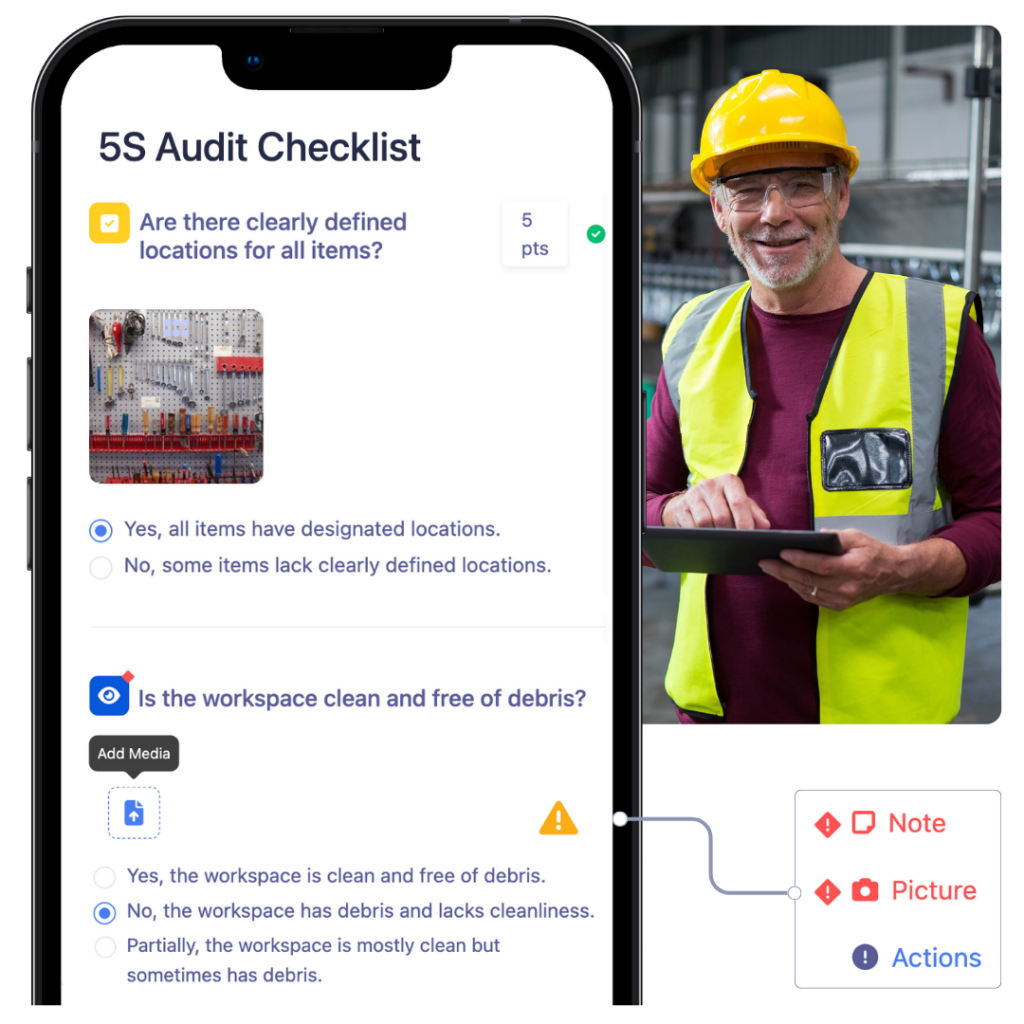
FAQ: 5S Audits
A 5S audit is a systematic review of a workplace to ensure adherence to the 5S principles: Sort, Set in Order, Shine, Standardize, and Sustain. It helps identify areas for improvement and maintain a clean, organized, and efficient workspace.
5S audits are crucial for:
- Improving productivity: By reducing waste and streamlining processes.
- Enhancing safety: By creating a clutter-free and well-organized environment.
- Boosting morale: By fostering a sense of pride and ownership among employees.
- Meeting quality standards: By ensuring consistent adherence to best practices.
The frequency of 5S audits depends on various factors, including the industry, the size of the workplace, and the level of adherence to 5S principles. However, it’s generally recommended to conduct audits:
- Initially: After implementing 5S principles.
- Regularly: Weekly, monthly, or quarterly to maintain standards.
- After significant changes: Such as new equipment, processes, or personnel.
A typical 5S audit checklist includes questions related to:
- Sort: Are unnecessary items removed?
- Set in Order: Are items organized efficiently?
- Shine: Is the workspace clean and tidy?
- Standardize: Are there clear procedures and standards in place?
- Sustain: Are 5S principles consistently followed?
Tervene offers a range of benefits for 5S audits, including:
- Efficient checklist creation: Quickly create and customize checklists.
- Real-time data collection: Capture and analyze data in real-time.
- Automated reporting: Generate detailed reports to track progress.
- Mobile accessibility: Conduct audits on the go with a mobile app.
- Integration with other systems: Seamlessly connect with other tools and software.
By leveraging a digital tool like Tervene, organizations can streamline their 5S audit process and achieve better results.

